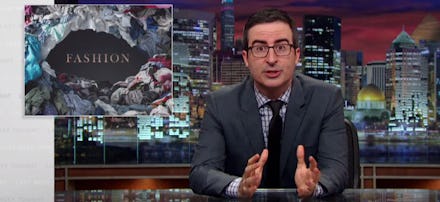John Oliver Points Out the Real Human Cost of Really Cheap Clothes

How do big clothing companies make any money?
This question was the focal point of Sunday's Last Week Tonight, as host John Oliver raised an important issue everyone needs to be talking about.
"Buying clothes is cheaper and easier than ever," said Oliver, pointing to an H&M dress which, at $4.95, costs less than a jar of cricket food. Everyone seems to win as prices have fallen while the corporations behind the magic have prospered; as Oliver notes, "the chairman of H&M is the 28th richest person in the world." But there's no such thing as a free lunch, and cheap clothes for America have come at a steep price around the world.
The real costs have been carried by cheap labor, often children, in faraway countries like Bangladesh and Cambodia. Popular clothing companies like Gap have been repeatedly busted for abuse and child labor in sweatshops overseas. When Gap claimed Cambodian factory workers as young as 12 had lied about their age, Oliver was't having it.
In one heartbreakingly ironic case, Oliver noted, children at a workshop in India were being used as virtual slave labor to produce clothes for Gap Kids. It was only one a string of allegations the company has faced over the years. Each time, offending companies have said they were isolated instances and the problems had been resolved, but Oliver was skeptical.
Oliver didn't let consumers off the hook either, and took several pointed shots at the people supporting the industry by giving in to ultra-cheap prices.
To drive the point home, Oliver announced he would be sending lunch to the heads of H&M, Gap, Walmart, Joe Fresh and Children's Place — and the meal would be made with the cheapest possible ingredients he could find. Oliver challenged the corporate titans to eat the food and even held an impromptu food/fashion show on the set.
Oliver sent a powerful message about an issue that needs to be talked about. While inexpensive clothes are attractive, their low prices are the result of a much higher human cost. Roughly 30 million people live in slave labor conditions around the world, the Walk Free Foundation's Global Slavery Index reported last year. And many of these workers are being employed by these large and well-known clothing companies.
"Companies all too often distance themselves from the labor working conditions in their supply chains," Liana Foxvog of the International Labor Rights Forum previously told Mic. "We find that all too often they also turn a blind eye to violations of worker rights in their supply."
"The conditions that garment workers face are often caused not only by the factory manager, but by the terms and conditions that the global retailers put on the factories, whether it's short turnaround times or high production quotes and small amounts of time to return the order," she added.
It's always nice to get a good deal on clothes, but it's also important to remember those savings have come at an often terrible cost to workers in faraway sweatshops. That fact should give everyone pause the next time they're at the checkout aisle.
Watch the full segment below: